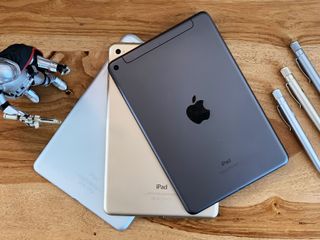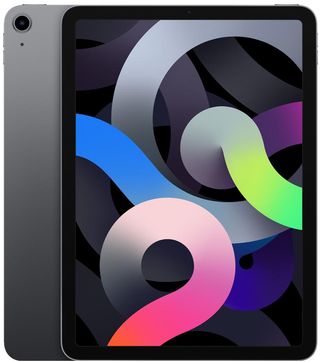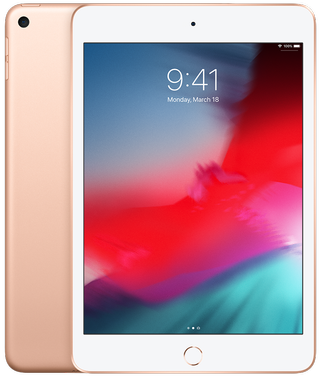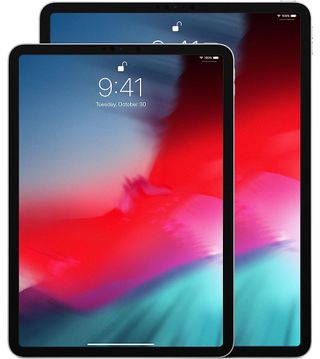iPad vs iPad Air vs iPad mini vs iPad Pro: Which should you buy?

When Steve Jobs first unveiled the iPad, you only had one 9.7-inch model to choose from. Over the years, though, Apple expanded the lineup to include the ultra-portable 7.9-inch iPad mini and the ultra-productive 12.9-inch iPad Pro.
Now, the 9.7 is finally, truly gone, and in its place, we have five different sizes stretched across five different price points — Entry-level 10.2-inch iPad 8, mid-range 7.9-inch iPad mini 5, 10.9-inch iPad Air 4, and high-end 11-inch and 12.9-inch iPad Pros. And, of course, all the color, storage, and cellular options for each.
And… it can seem like a lot. I get it. I totally get it. But it doesn't have to be. Keep reading, and we'll quickly, simply hone things down to the best iPad for you.

Go Deeper
I'm only skimming the details here. For far deeper dives, check out my specific reviews for all of these iPads.
The iPad Flow
OK, so, picking your next iPad. Apple used to do grids, but I prefer flows. You start at the beginning, and you stop where it makes sense.
- If you just want an iPad, you can take pretty much anywhere and do pretty much anything with, then you have the new normal, the new baseline, the new 10.9-inch iPad Air 4, starting at $599.
- If you absolutely have to have an iPad but you just can't or won't pay that much for it, then you have the 10.2-inch iPad (2020) — no adjective added, starting at $329
- If maximum portability is most important to you, and you're not only willing but eager to give up some screen size to get it, then there's the 7.9-inch brand new iPad mini 5, starting at $399.
- If you want more power and performance but still a good amount of portability, and premium is no problem, then there's the newly redesigned 11-inch iPad Pro (2020), starting at $799.
- And if you demand not only power and performance but the biggest screen you can get, you can go all the way up to the newly redesigned 12.9-inch iPad Pro (2020), starting at $999.
That's still five stops on the flow, with room to fuss with the options in between them, so if you still need help making up your mind, let's dive a little deeper.
iPad Air 4: So close to pro
If you need an iPad and that's all you really know or care about, if you're just starting out with tablets or looking to upgrade after a few or many years, if you just want to be able to do everything that an iPad can do, from reading to watching to communicating to working to playing, get the new iPad Air.
Master your iPhone in minutes
iMore offers spot-on advice and guidance from our team of experts, with decades of Apple device experience to lean on. Learn more with iMore!
If you've got a previous iPad Air, or you've just been paying attention to the lineup, the first thing you'll notice is the design. The iPad Air has taken on the flat sides of the current iPad Pro and the near-edge-to-edge display surrounded by even bezels. The Home button is gone, but Touch ID remains, housed now in the sleep/wake button near one of the corners of the device. It also comes equipped with USB-C, replacing the Lightning connector as the single physical port on the tablet.
It's got a 10.9-inch, wide gamut, Retina display, with TrueTone ambient color temperature matching, which is slightly bigger than the original iPad. It also comes with Apple's brand new A14 Bionic chipset, two stereo speakers, a 7-megapixel, 1080p front-facing camera with an f/2.2 aperture, and a 12 megapixel, wide color f/1.8 rear camera that's capable of recording 4K video at 24fps, 30fps, and 60fps.
You can get it in Silver, Space Gray, Rose Gold, Green, and Sky Blue. You can choose either 64GB or 264GB of storage, and with just Wi-Fi or with Wi-Fi and cellular, so you can connect or share that connection from anywhere.
It's also compatible with the second-generation Apple Pencil, Logitech Crayon, Apple Smart Keyboard Folio, and Magic Keyboard for iPad for drawing and typing. They do increase the up-front cost but also the functionality.
In other words, the iPad Air can do everything a modern iPad needs to do, starting at $599.

The iPad Air 4 (2020) brings an almost full-on, pro-level feature set (and design) with it for a lower price. That makes the new everyday iPad perfect for just about everyone.
iPad (2020): The budget option
If you need a first or new iPad and price is the essential feature to you, if you're a student or a teacher or just want an iPad to work and play with part-time, something that does all the iPad stuff but just doesn't cost as much, get the iPad (2020).
Here's what you give up:
The design remains the same from the previous model: the screen is smaller, standard rather than wide color, with no TrueTone, so it can look slightly blueish or yellowish-white depending on the lighting, and non-laminated, but it's every bit as high resolution. And even though it's physically smaller, it's ever so slightly heavier than Air. It also has an older A12 Bionic processor, a Lightning connector, Touch ID, two stereo speakers, a 1.2 megapixel, 720p front-facing camera, and an 8 megapixel, standard color, f/2.4, also 1080p rear camera.
You can get it in silver, space gray, or gold, with 32 or 128GB of storage, and with just Wi-Fi or with Wi-Fi and cellular. It's compatible with the 1st generation Apple Pencil, Logitech Crayon, and the Apple Smart Keyboard, as well.
Here's what you gain:
Savings. Sure, you get less, but if you don't need more, you're also going to pay a lot less — starting at just $329.

The new entry-level iPad has everything last year's had, plus a bigger 10.2-inch display, and optional gigabit LTE and Smart Keyboard support.
iPad mini 5: The ultralight
If you love everything about the iPad Air but just want something smaller, something you can tuck away into a jacket pocket or, sure, even the back pocket of your non-skinny non-hipster jeans, that you can easily take everywhere and do… well… most things with, then check out the new iPad mini 5.
Here's what's the same:
The iPad mini 5 has almost all the same stats as the iPad Air 3 — wide gamut, Retina display, Apple's A12 Bionic chipset, 3GB of memory, a Lightning connector, Touch ID two stereo speakers, a 7 megapixel, 1080p front-facing camera, and an 8 megapixel, wide color f/2.4, also 1080p rear camera.
And yeah, you can also get it in silver, space gray, or gold, with 64 or 264GB of storage, and with just Wi-Fi or with Wi-Fi and cellular, so you can connect or share that connection from anywhere. And it's compatible with the 1st generation Apple Pencil and Logitech Crayon, so you can do all your drawing, markup, note-taking, and precision editing.
Here's what you give up:
The iPad mini 5 doesn't have a Smart Connector like the Air, so you can't get a tiny Smart Keyboard to go with it, though it'll still work with any standard Bluetooth keyboard.
Here's what you gain:
It packs all of that previous Air tech and performance in device with a 7.9-inch display that only about 2/3rds as much as the Air. That means it's got almost everything that's great about the new iPad Air, just in new iPad mini shrunken size — starting at $399.

Judge it not by its size, for A12 is its ally.
If you don't just want less expensive, but you also want smaller, the iPad mini 5 (2019) delivers almost the full iPad Air 3 experience at a fraction of the size, weight, and price.
iPad Pro (2020): The Powerhouse
If you need a new iPad and you want it for "real work" (TM) (C) (R), if you're a pro photographer, videographer, audio producer or engineer, designer or musician, if time is money and power is worth a premium, then you want the iPad Pro.
Here's what you give up:
The iPad Pro (2020) has the same design as that old iPad Pro: bezel-free with Face ID. So there's no Touch ID sensor like the other models, but authentication for most things on the iPad Pro doesn't require additional action.
You also lose Lightning, Apple's — can I call it venerable yet? — iOS connector in favor of the more Mac-like, and increasingly standard USB-C connector.
And… there's no gold finish option because pros are way too serious for that.
Here's what you gain:
You still have a ProMotion display that can dynamically ramp down to save power and up to 120Hz for silky smooth scrolling. Apple's A12Z Bionic system-on-a-chip isn't a significant upgrade from the A12X, featuring one additional graphics processing core, but there's a new thermal system, allowing the chip to sustain higher performance for longer. Given the performance of the A12X, this can only mean good things. All models of the iPad Pro (2020), 128GB, 256GB, 512GB, and 1TB, now have 6GB of RAM, which was restricted to the 1TB model of the 2018 iPad Pro. It's a bit more performance headroom for everyone.
You've also got four speakers, a hallmark of the Pro line, and now two cameras, a 12-megapixel wide-angle unit at f/1.8, and a 10-megapixel ultra-wide camera at f/2.4. These cameras can record video at 4K at 60 frames-per-second. And of course, there's the TrueDepth camera on the front that makes up the Face ID apparatus.
You've also got LiDAR, Light Detection and Ranging, in the camera module. This is a new sensor that can scan the environment around it (up to five meters away) to aid in augmented reality applications. It allows for better placement of AR objects and features like object occlusion, which allow virtual items to behave realistically and remain in place when behind real-world items.
You can get Wi-Fi or cellular, and the new iPad Pro also supports Apple's new, second-generation Pencil, which connects magnetically to the side of the iPad Pro and charges inductively, has a new soft-touch finish, and you can tap it to change tools or do other, simple toggles.
It also has a new, simpler Smart Keyboard, which also protects the back of the pad.
And it again comes in both 11-inches, which is similar in overall size to the 10.9-inch Air, and 12.9-inches, which is the biggest iPad canvas you can currently get, but, thanks to the new design, doesn't feel that way anymore.
It's literally maximum iPad starting at $799 for 11-inches and $999 for 12.9-inches.

Yeah, it's a lot of money, but if you're a hardcore, keyboard pounding, pixel-pushing, 4K rendering, code crunching, music-making, design doodling pro, and your time is worth more than money, and you'll pay just about anything for performance, then you want the iPad Pro.
The iPad Flow: Redux
OK, I know that got a little complicated, especially towards the end there. So I'm going to rewind and bring it right back to the beginning.
- If you just want an iPad, you can take pretty much anywhere and do pretty much anything with, then you have the new normal, the new baseline, the new 10.9-inch iPad Air 4, starting at $599.
- If you absolutely have to have an iPad but you just can't or won't pay that much for it, then you have the 10.2-inch iPad (2020) — no adjective added, starting at $329
- If maximum portability is most important to you, and you're not only willing but eager to give up some screen size to get it, then there's the 7.9-inch brand new iPad mini 5, starting at $399.
- If you want more power and performance but still a good amount of portability, and premium is no problem, then there's the newly redesigned 11-inch iPad Pro (2020), starting at $799.
- And if you demand not only power and performance but the biggest screen you can get, you can go all the way up to the newly redesigned 12.9-inch iPad Pro (2020), starting at $999.
And if you're still not sure, just get the new 10.2 iPad 8 and enjoy.
Joseph Keller is the former Editor in Chief of iMore. An Apple user for almost 20 years, he spends his time learning the ins and outs of iOS and macOS, always finding ways of getting the most out of his iPhone, iPad, Apple Watch, and Mac.
Most Popular




